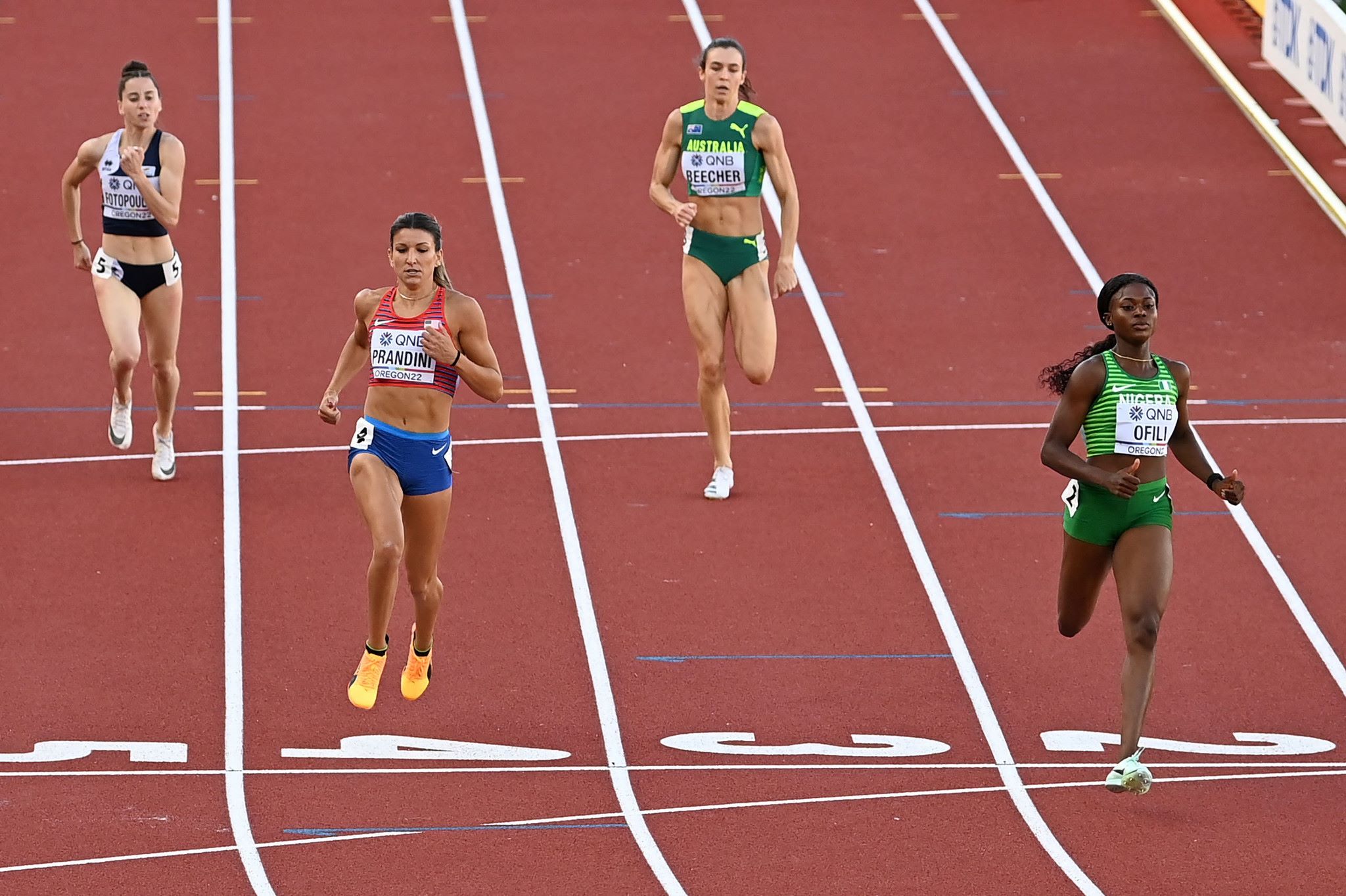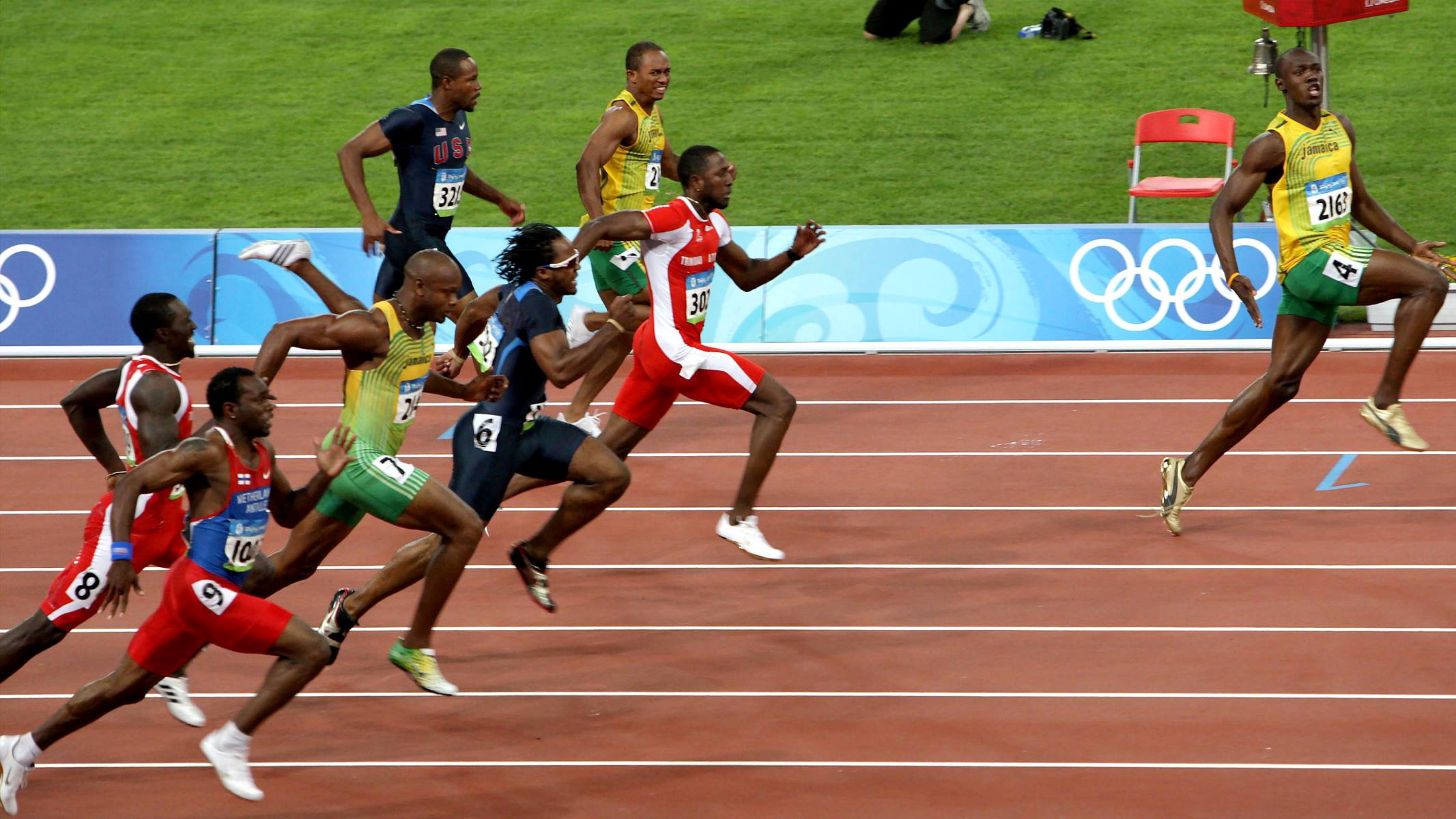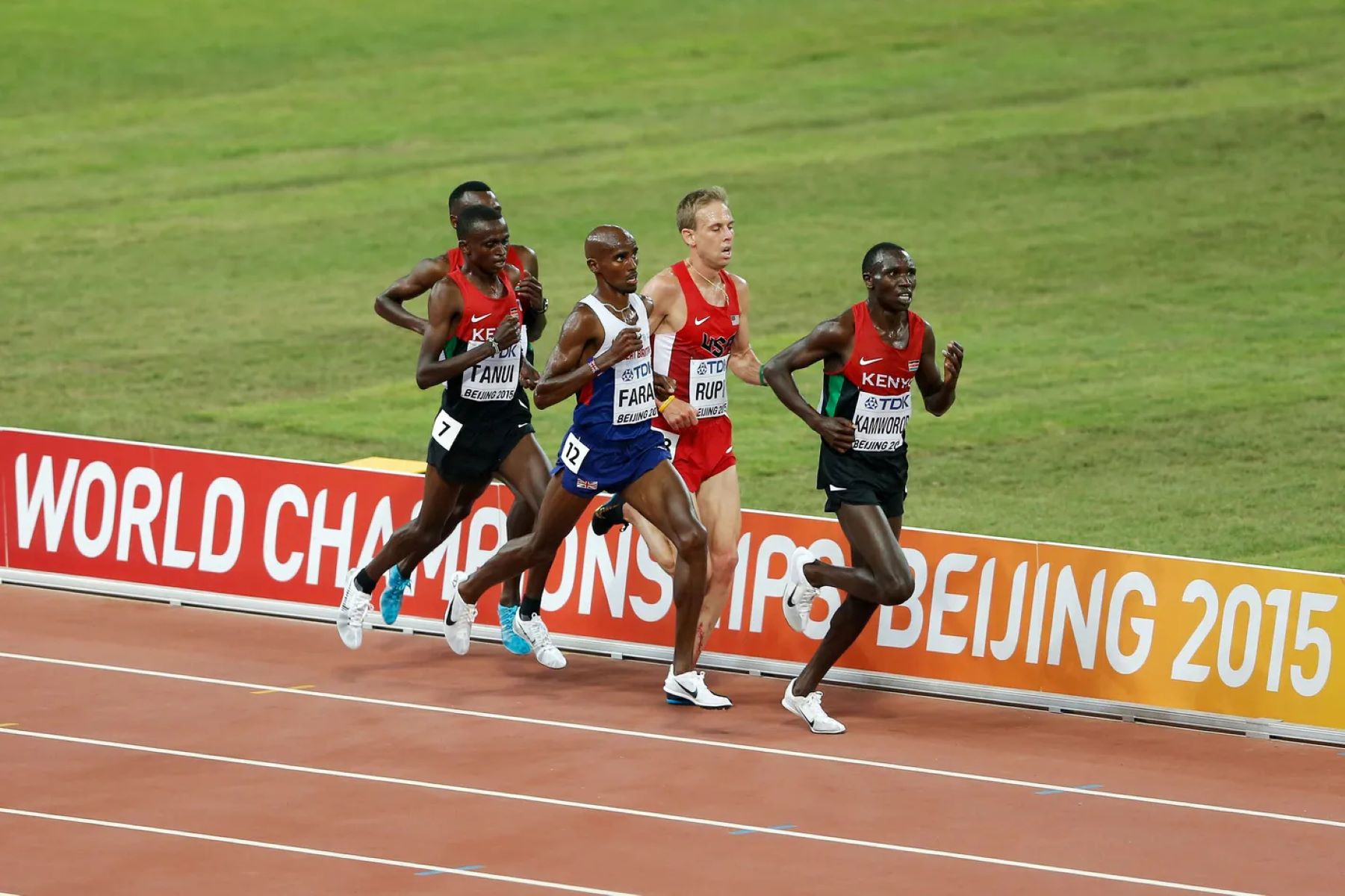Home>Misc>Featured>How To Become A Professional Track And Field Athlete


Featured
How To Become A Professional Track And Field Athlete
Modified: January 2, 2024
Learn the steps and techniques to become a featured professional track and field athlete. Unlock your full potential in this highly competitive sport with proven training methods.
Introduction
Being a professional track and field athlete is a dream for many sports enthusiasts. The thrill of racing against the best athletes, the adrenaline rush of breaking records, and the sense of accomplishment from representing your country on the global stage are just a few of the rewards that come with this pursuit. However, the path to becoming a professional track and field athlete is not easy. It requires a strong dedication, perseverance, and a strategic approach.
In this article, we will guide you through the steps involved in becoming a professional track and field athlete. From goal setting to finding a coach, building strength and endurance to mastering the techniques, we will provide you with valuable insights and tips to help you navigate your journey towards career excellence in track and field.
While there is no guaranteed formula for success, by following the guidelines outlined in this article and putting in the hard work, you can increase your chances of reaching your full potential as a track and field athlete. Whether you aspire to compete at local, national, or international levels, the principles discussed here will serve as a solid foundation for your athletic journey.
It’s important to note that the path to becoming a professional track and field athlete is not a sprint, but rather a marathon. It requires commitment, determination, and resilience. There will be setbacks and obstacles along the way, but with the right mindset and strategies, you can overcome them and continue to progress towards your goals.
So, if you are ready to embark on this exciting journey and are willing to put in the time and effort required, then let’s dive in and explore the steps to becoming a professional track and field athlete.
Setting Goals
Setting goals is an essential first step in becoming a professional track and field athlete. Your goals will provide you with a clear direction and motivate you to make progress on your athletic journey. When setting goals, it’s important to be specific, measurable, achievable, relevant, and time-bound.
Start by identifying your long-term goal. Where do you see yourself in the future? Is it competing in the Olympic Games? Becoming a world champion? Representing your country at international events? Be ambitious and dream big. This will be the ultimate driving force behind your training and competitions.
Once you have your long-term goal, break it down into smaller, more manageable short-term goals. For example, if your long-term goal is to compete in the Olympic Games, a short-term goal could be to qualify for your national team or improve your personal best in a specific event.
When setting your goals, make sure they are realistic and achievable. Consider your current abilities, resources, and limitations. Setting unattainable goals can lead to frustration and disappointment. It’s better to set smaller, achievable goals that can progressively lead you towards your long-term objective.
Additionally, make your goals measurable. Define specific metrics that will allow you to track your progress. For instance, if your goal is to improve your speed, you can set a specific target time that you want to achieve in a certain distance.
Relevance is another important factor to consider when setting goals. Ensure that your goals align with your passion, values, and interests. When you are motivated and have a genuine passion for what you are pursuing, it will be easier to stay committed and overcome obstacles along the way.
Lastly, set time-bound goals. Assign deadlines to your goals to create a sense of urgency and keep you focused. Break them down into weekly, monthly, or yearly targets, depending on the nature of the goal. Regularly review and adjust your goals as you progress and as new opportunities or challenges arise.
Remember, goal setting is not a one-time event. It is an ongoing process that requires regular evaluation and adjustment. As you accomplish your goals, celebrate your achievements and set new ones to keep pushing yourself to reach new heights.
Developing a Training Plan
Developing a well-structured training plan is crucial for the progress and success of a track and field athlete. A training plan allows you to optimize your workouts, ensure consistency, and prevent injury. Here are some key steps to consider when developing your training plan:
- Evaluate your current fitness level: Before designing your training plan, assess your current fitness level to determine your strengths and areas for improvement. This will help you customize your training to address specific needs.
- Identify your event(s) and focus: Track and field offers a wide range of events, from sprints to distance running, jumping, throwing, and more. Choose the event(s) you’re most interested in and focus your training accordingly. Specializing in a specific event will allow you to target your training efforts and improve your performance in that discipline.
- Balance different types of training: A well-rounded training plan should include a mix of aerobic endurance, speed, agility, strength, and flexibility exercises. This will help you develop the necessary qualities for your event(s) while reducing the risk of overuse injuries.
- Progressive overload: Gradually increase the intensity, duration, or difficulty of your workouts over time. This progressive overload principle ensures that you are continually challenging your body and making progress.
- Include recovery days: Allowing your body to rest and recover is equally important as training itself. Plan regular rest days in your training schedule to prevent overtraining and promote optimal performance.
- Seek professional guidance: If possible, work with a qualified track and field coach or trainer who can help you develop an individualized training plan based on your specific goals, fitness level, and event(s) of focus. They can provide expert guidance and monitor your progress.
- Monitor and track your progress: Keep a training journal to log your workouts, track improvements, and identify areas that need additional attention. This will help you stay organized, motivated, and accountable.
Remember, consistency is key when it comes to training. Stick to your plan, follow a disciplined routine, and make adjustments as necessary. Always listen to your body and prioritize injury prevention. With a well-designed training plan, dedication, and hard work, you’ll be on your way to achieving your goals as a track and field athlete.
Finding a Coach
Having a knowledgeable and experienced coach by your side is invaluable in your journey to becoming a professional track and field athlete. A coach can provide guidance, expertise, and support to help you reach your full potential. Here are some steps to consider when finding the right coach:
- Do your research: Start by researching coaches in your local area or at training centers and clubs. Look for coaches who specialize in your event(s) of interest and have a track record of working with successful athletes.
- Seek recommendations: Ask fellow athletes, trainers, or sports professionals for recommendations. They may be able to provide insights on reputable coaches who have a good reputation for developing athletes.
- Contact governing bodies: Reach out to the national or regional governing bodies for track and field in your country. They can provide you with a list of certified coaches who meet specific standards and qualifications.
- Attend track meets: Attend local and regional track meets to observe coaches in action. Observe how they interact with their athletes, their coaching styles, and their ability to provide constructive feedback.
- Arrange meetings: Once you have identified potential coaches, arrange meetings or consultations with them. Discuss your goals, aspirations, and training needs. It’s important to find a coach who understands your objectives and shares a similar training philosophy.
- Assess communication and compatibility: Building a strong coach-athlete relationship is essential for success. Pay attention to how well you communicate with the coach and whether you feel comfortable asking questions or expressing concerns. A good coach should be able to provide clear instructions and guidance.
- Consider availability and commitment: Determine the coach’s availability and commitment to your training. Assess whether they have the necessary time and resources to dedicate to your development as an athlete.
- Review their track record: Inquire about the coach’s experience working with athletes at different levels, their success stories, and their coaching philosophy. Request references from past or current athletes to get a better understanding of their coaching methods and effectiveness.
Finding the right coach may take time and effort, but it is crucial to ensure that you have someone who can guide and support you on your journey. Remember, a coach is not only there to provide technical expertise but also to motivate and inspire you to perform at your best. With a dedicated coach by your side, you’ll be well-equipped to overcome challenges, improve your skills, and achieve your goals in track and field.
Building Strength and Endurance
Building strength and endurance is essential for track and field athletes to perform at their best. Whether you are a sprinter, jumper, or distance runner, incorporating specific exercises and training techniques can help you enhance your physical capabilities. Here are some key strategies to build strength and endurance:
- Resistance training: Incorporate regular resistance training into your workout routine. Focus on exercises that target the muscles involved in your event(s), such as squats, lunges, deadlifts, and plyometric exercises. Gradually increase the weight and intensity to build muscular strength and power.
- Interval training: Interval training involves alternating periods of high-intensity exercise with recovery periods. This type of training helps improve cardiovascular endurance and builds a strong aerobic base. Integrate interval workouts into your training plan, such as sprint intervals, hill repeats, or fartlek sessions.
- Cross-training: Engage in cross-training activities to develop overall fitness and prevent overuse injuries. Try activities such as swimming, cycling, or yoga to improve flexibility, balance, and supplemental muscle development.
- Long slow distance runs: Endurance runners should incorporate long slow distance (LSD) runs into their training. These runs help develop aerobic capacity and improve your ability to sustain a steady pace over long distances. Gradually increase the duration and distance of your LSD runs over time.
- Hill training: Hill workouts can help build strength, power, and mental toughness. Incorporate hill sprints or hill repeats into your training plan to work your lower body muscles and develop explosive power.
- Core and stability exercises: A strong core and stability are essential for all track and field athletes. Include exercises that target your core muscles, such as planks, Russian twists, and bird-dogs. These exercises improve posture, balance, and body control.
- Proper recovery: Adequate recovery is crucial for building strength and endurance. Allow time for rest, sleep, and recovery days in your training plan. Additionally, prioritize proper nutrition and hydration to fuel your body effectively and support muscle repair and growth.
- Progressive overload: Continually challenge your body by gradually increasing the intensity, duration, or difficulty of your workouts. This principle of progressive overload ensures that you are continually pushing your limits and making improvements.
Remember, consistency and dedication are key when it comes to building strength and endurance. Stick to your training plan, listen to your body, and make adjustments as necessary. With a well-rounded approach and a focus on building both strength and endurance, you’ll be well-prepared to excel in your chosen track and field events.
Nutrition and Hydration
Nutrition and hydration play a critical role in the performance and overall well-being of track and field athletes. Proper fueling and hydration can enhance your energy levels, optimize recovery, and support muscle growth and repair. Here are some key tips for maintaining a healthy and balanced diet:
- Stay hydrated: Hydration is crucial for optimal performance. Drink water regularly throughout the day, especially during training sessions and competitions. Monitor your urine color; pale yellow indicates good hydration, while dark yellow suggests dehydration.
- Focus on nutrient-dense foods: Consume a variety of whole foods that are rich in nutrients, such as fruits, vegetables, lean proteins, whole grains, and healthy fats. These foods provide the necessary vitamins, minerals, and antioxidants to support your overall health and athletic performance.
- Meet your energy needs: Track and field athletes have high energy demands. Consume enough calories to meet your energy requirements, based on your training intensity and body composition goals. Consult with a registered dietitian or sports nutritionist to determine your specific needs.
- Time your meals and snacks: Aim to eat regular meals and snacks throughout the day to maintain a steady supply of energy. Prioritize nutrient-rich meals before and after training to support performance and recovery.
- Carbohydrates for energy: Carbohydrates are the primary fuel source for track and field athletes. Include complex carbohydrates, such as whole grains, fruits, and vegetables, in your meals to provide sustained energy for training and competition.
- Protein for recovery: Protein is essential for muscle repair and growth. Include lean sources of protein in your meals, such as lean meats, poultry, fish, eggs, dairy products, legumes, and plant-based proteins.
- Don’t neglect fats: Healthy fats are important for hormone production, cell health, and energy storage. Include sources of unsaturated fats, such as avocados, nuts, seeds, and olive oil, in your diet.
- Recovery nutrition: After training or competitions, prioritize post-workout nutrition. Consume a mix of carbohydrates and protein within 30 minutes to replenish glycogen stores and support muscle recovery.
- Supplement wisely: While a well-rounded diet should provide most of the nutrients you need, consider supplementing with vitamins or minerals if advised by a healthcare professional or sports dietitian.
Remember, nutrition is highly individualized, and what works for one athlete may not work for another. Experiment with different foods, meal timings, and hydration strategies during training to identify what works best for you. Working with a sports nutritionist can provide personalized guidance to optimize your nutrition and hydration for improved performance in track and field.
Mastering the Techniques
Track and field is a sport that requires mastering specific techniques to excel in your chosen events. Regardless of whether you’re a sprinter, jumper, thrower, or middle-distance runner, focusing on proper technique is crucial for achieving optimal performance. Here are some key tips to help you master the techniques in track and field:
- Seek expert coaching: Work closely with a knowledgeable coach who specializes in your event. They can provide guidance, correct technical errors, and help you refine your technique.
- Break down the movements: Analyze and break down each movement in your event to understand the correct body position, form, and timing. Focus on mastering the fundamental movements before progressing to more advanced techniques.
- Practice regularly: Consistent practice is essential for ingraining correct technique. Set aside dedicated practice sessions to focus solely on technique, even if it means sacrificing intensity or volume in your training.
- Use video analysis: Utilize video analysis to identify and correct technical flaws. Record your performances or training sessions and review them with your coach to identify areas for improvement.
- Focus on body control and alignment: Pay attention to your body control, alignment, and balance during each movement. Proper body positioning and alignment are key to generating power, speed, and efficiency.
- Break bad habits: Be mindful of any bad habits or incorrect techniques that you may have developed. With the help of your coach, work on breaking these habits and replacing them with proper techniques.
- Develop strength and flexibility: Building strength in the specific muscles used in your event is crucial for technique mastery. Incorporate strength and flexibility exercises that target those muscles to improve overall performance.
- Visualize success: Visualization is a powerful tool for improving technique. Imagine yourself executing each movement flawlessly and visualize the desired outcome. This mental rehearsal can help enhance muscle memory and improve performance.
- Focus on the details: Pay attention to the finer details of your technique, such as arm and leg placement, body posture, and timing. Small adjustments and refinements in these areas can make a significant difference in your performance.
- Implement progressive drills and progressions: Incorporate specific drills, exercises, and progressions into your training to reinforce proper technique and gradually advance your skill level.
Remember, mastering technique takes time, patience, and dedication. Be open to feedback, embrace the learning process, and stay persistent. By devoting time and effort to perfecting your technique, you’ll maximize your potential and achieve success in track and field.
Mental Preparation and Focus
Mental preparation and focus are just as important as physical training when it comes to achieving success in track and field. Developing a strong mental game can help you overcome challenges, stay calm under pressure, and perform at your best. Here are some key strategies for mental preparation and focus:
- Set clear intentions: Set clear goals and intentions for each training session and competition. Visualize yourself achieving those goals and focus on the process rather than just the outcome.
- Develop a routine: Establish a pre-competition routine that helps you get into the right mindset. This routine can include visualization exercises, breathing techniques, or specific warm-up drills that help you feel focused and mentally prepared.
- Practice mental imagery: Use mental imagery to envision yourself successfully executing your event. Imagine the details of the environment, the movements, and the sensations. This helps build confidence and familiarity.
- Cultivate self-belief: Develop a belief in your abilities and strengths as an athlete. Positive self-talk, affirmations, and focusing on past successes can help build your confidence and self-belief.
- Control your emotions: Learn to manage your emotions and stay composed during competitions. Techniques such as deep breathing, mindfulness, or visualization can help you stay calm and focused.
- Stay present: Avoid getting caught up in past performances or worrying about future outcomes. Stay focused on the present moment and the task at hand to perform at your best.
- Embrace challenges: Train yourself to embrace challenges and view them as opportunities for growth. Adopting a growth mindset allows you to learn from setbacks and maintain a positive attitude.
- Stay resilient: Track and field can be a sport of highs and lows. Build resilience by learning from failures, staying motivated, and bouncing back from setbacks with determination.
- Learn from experience: Reflect on past performances and experiences to identify areas for improvement. Celebrate your successes but also analyze areas where you can grow and develop.
- Seek support: Seek support from coaches, teammates, or sports psychologists who can provide guidance and help you develop mental strategies specific to track and field.
Remember, mental preparation and focus are ongoing practices that require consistency and dedication. By investing time and effort into developing your mental game, you’ll be better equipped to handle the pressures of competitive track and field and optimize your performance.
Competing at Local Level
Competing at the local level is a crucial step in the journey of becoming a professional track and field athlete. Local competitions provide valuable opportunities to showcase your skills, gain experience, and lay the foundation for future success. Here are some tips to excel at the local level:
- Research and participate in local meets: Find local track and field meets in your area and register to compete. Check with your coach or local athletic associations for information on upcoming events.
- Set realistic goals: Set specific, achievable goals for each competition. Focus on improving your personal bests or targeting specific performance markers rather than solely focusing on winning.
- Stay consistent with training: Maintain a consistent training schedule and follow your training plan leading up to the competition. Consistency in training will help you build fitness, technique, and confidence.
- Warm up properly: Dedicate time to warm up your body before each event. This helps prepare your muscles, increases blood flow, and reduces the risk of injury.
- Focus on your performance: During the competition, focus on executing your race or event to the best of your abilities. Avoid getting distracted by other competitors and maintain mental focus throughout.
- Learn from each competition: Treat each local competition as a learning opportunity. Assess your performance, analyze areas for improvement, and identify strategies to implement in your future training.
- Embrace the competitive atmosphere: Use the local competitions to experience the thrill of competition and learn how to handle nerves. Embrace the competitive atmosphere and learn from the intensity of the environment.
- Build relationships: Interact with fellow athletes, coaches, and officials at local meets. Networking and building relationships in the track and field community can open doors to future opportunities.
- Be a good sport: Demonstrate good sportsmanship and respect towards your competitors, coaches, and officials. Be supportive, congratulate others on their accomplishments, and learn from those who perform better than you.
- Stay motivated: Use each local competition as motivation to improve and progress. Celebrate your achievements and use any setbacks as fuel to work harder and grow as an athlete.
Remember, competing at the local level is just the beginning of your track and field journey. Embrace the opportunities, learn from every experience, and continue to set new goals as you develop and progress towards higher levels of competition.
Competing at National and International Levels
Competing at the national and international levels in track and field is the culmination of years of hard work, dedication, and a strong performance at the local level. These higher-level competitions present unique challenges and opportunities for athletes to showcase their skills on a bigger stage. Here are some strategies to excel at the national and international levels:
- Qualify for national competitions: Meet the qualifying standards set by your national governing body to participate in national-level competitions. These events attract top athletes and provide opportunities for greater exposure and recognition.
- Set specific performance goals: Set clear and ambitious performance goals for national and international competitions. Whether it’s achieving a personal best, making it to a specific round, or finishing among the top competitors, having specific goals will help guide your training and focus.
- Research and understand the competition: Study the competition at the national and international levels. Familiarize yourself with the top athletes in your event and analyze their strategies, performances, and strengths. This knowledge can inform your own training and competition approach.
- Seek guidance from experienced coaches: Work closely with experienced coaches who have expertise in preparing athletes for national and international competitions. They can help you fine-tune your training, provide insights on competition strategies, and offer guidance on mental preparation.
- Evaluate and adjust your training plan: Assess your training plan regularly to ensure it aligns with the demands of national and international competitions. Make necessary adjustments to cater to the increased intensity, competition schedules, and travel requirements.
- Manage nerves and perform under pressure: Develop mental strategies to manage nerves and perform under pressure. Techniques such as visualization, deep breathing, and positive self-talk can help you stay focused and in control during high-stakes competitions.
- Learn from each competition: Reflect on your performance after each national and international competition. Analyze your strengths and areas for improvement, identify lessons learned, and incorporate those insights into your training plan moving forward.
- Network and build connections: Take advantage of the larger competitive environment to network and build connections with athletes, coaches, and officials from around the world. Building relationships in the track and field community can create opportunities for future collaborations and experiences.
- Stay motivated and resilient: The journey to compete at the national and international levels is challenging. Stay motivated, remain resilient in the face of setbacks, and use each competition as fuel to work harder and continuously improve.
- Celebrate achievements: Acknowledge and celebrate your achievements at the national and international levels. Even if you don’t achieve all of your goals, recognize the progress you’ve made and the experience gained. Use this as motivation to push yourself further in your athletic career.
Remember, competing at the national and international levels requires continued commitment, perseverance, and a growth mindset. Embrace the challenges, learn from the experiences, and continue striving for excellence as you represent your country on the global stage of track and field.
Seeking Sponsorship and Endorsements
Seeking sponsorship and endorsements is an important step for professional track and field athletes to secure financial support and build their personal brand. Sponsorships not only provide financial backing but also help raise an athlete’s profile and create opportunities for future growth. Here are some strategies for seeking sponsorship and endorsements:
- Build a strong personal brand: Develop a unique and compelling personal brand that represents your values, achievements, and personality. Showcase your skills, story, and journey through social media, a professional website, and engaging content.
- Identify potential sponsors: Research and identify companies or brands that align with your values and target audience. Look for corporations, sportswear companies, local businesses, or companies that support athletic development.
- Create a sponsorship proposal: Craft a professional sponsorship proposal that outlines your achievements, future goals, and the value you can bring to potential sponsors. Include details about your media exposure, social media following, and any unique selling points that differentiate you from other athletes.
- Reach out to potential sponsors: Make direct contact with potential sponsors by sending your sponsorship proposal or attending industry events where you can network and make connections. Personalize your outreach to demonstrate your genuine interest in partnering with their brand.
- Highlight mutually beneficial opportunities: Showcase how a partnership with you can benefit the potential sponsor. Highlight the exposure and reach their brand can gain by associating with a successful and influential athlete like yourself.
- Develop relationships: Building relationships is crucial in securing sponsorship and endorsements. Attend conferences, industry events, and networking opportunities to connect with decision-makers in the sports marketing industry. Nurture these relationships and showcase your professionalism, work ethic, and dedication to your sport.
- Offer promotional opportunities: Demonstrate your willingness to promote the sponsor’s brand by offering opportunities for logo placement, product endorsements, social media shout-outs, or personal appearances at their events. Show them the value they will receive in exchange for their support.
- Consider local partnerships: Seek sponsorship from local businesses, organizations, or community groups. Local support can be a stepping stone towards securing larger and more lucrative sponsorships as you progress in your career.
- Engage in corporate social responsibility: Showcase your involvement in charity work or community initiatives. Aligning yourself with a cause or using your platform for good can attract sponsors who resonate with the values you stand for.
- Be professional and grateful: Treat potential sponsors with respect, professionalism, and gratitude. Respond promptly to inquiries, express appreciation for their consideration, and provide regular updates on your progress and achievements.
Remember, the sponsorship and endorsement process requires time and persistence. Not every outreach will result in a partnership, but by being strategic, professional, and showcasing your unique value, you increase your chances of securing meaningful sponsorships and endorsements that can support your athletic journey.
Managing Injuries and Recovery
Managing injuries and prioritizing recovery is crucial for the long-term success and well-being of track and field athletes. The demanding nature of the sport puts athletes at risk of various injuries, and proper management is essential to ensure timely healing and a safe return to training. Here are some key strategies for managing injuries and prioritizing recovery:
- Listen to your body: Pay attention to any warning signs or discomfort in your body. Recognize the difference between normal training soreness and potential injury symptoms. Rest and seek medical advice if you suspect an injury.
- Seek professional medical help: Consult with a sports medicine physician or a qualified healthcare professional for an accurate diagnosis and treatment plan. They can provide expert advice and guidance tailored to your specific injury.
- Follow a rehabilitation plan: Adhere to the prescribed rehabilitation plan provided by your healthcare professional. This may include specific exercises, physiotherapy, or other modalities to promote healing and restore function.
- Gradually return to training: Progressively reintroduce training activities as advised by your healthcare professional. Gradual and controlled return minimizes the risk of reinjury and allows your body to adjust to the demands of training again.
- Implement cross-training and low-impact activities: If you are unable to train at full intensity due to injury, incorporate cross-training or low-impact activities that do not aggravate the injury. This helps maintain fitness levels and prevents deconditioning.
- Focus on nutrition and hydration: Optimize your nutrition and hydration to support the healing process. Consume a balanced diet rich in nutrients and stay hydrated to facilitate tissue repair and recovery.
- Get sufficient rest and sleep: Allow your body adequate time to rest and recover. Sleep is essential for tissue repair and hormone regulation, which supports overall recovery.
- Manage stress and mental well-being: Injury recovery can be mentally challenging. Practice stress-management techniques such as meditation, deep breathing, or engaging in activities that bring you joy. Seek support from friends, family, or a sports psychologist if needed.
- Communicate with your coach and support team: Keep your coach and support team updated on your injury and recovery progress. They can help modify your training plan, provide additional guidance, and offer support throughout the recovery process.
- Prevent future injuries: Once you have recovered, prioritize injury prevention through appropriate warm-ups, cool-downs, stretching, and strength training. Address any biomechanical imbalances or weaknesses that may contribute to injury.
- Be patient and trust the process: Recovery takes time, and it is important to be patient with the healing process. Trust in your rehabilitation plan, listen to your healthcare professionals, and gradually build back your strength and fitness.
Remember, managing injuries and prioritizing recovery is a crucial component of any athlete’s journey. By giving your body the time, attention, and care it needs to heal, you can recover effectively and get back to training and competing at your full potential.
Balancing School or Work with Athletics
Finding a balance between school or work commitments and athletics can be challenging for track and field athletes. However, with proper planning, time management, and prioritization, it is possible to pursue your athletic goals while also meeting academic or professional responsibilities. Here are some strategies to help you balance school or work with athletics:
- Create a schedule: Plan your time effectively by creating a schedule that includes dedicated blocks for training, studying, and work. Prioritize your commitments and allocate specific time slots for each activity.
- Communicate with teachers or employers: Inform your teachers or employers about your athletic commitments and discuss any potential conflicts or accommodations that may be necessary. Clear communication can help them understand your situation and work with you to find solutions.
- Maximize your time: Make the most of the time you have available by utilizing breaks, commuting time, or downtime between classes or meetings. Use these pockets of time for quick tasks or studying to maximize productivity.
- Prioritize tasks: Identify the most important tasks or assignments and prioritize them accordingly. Focus on completing high-priority tasks first to ensure that they receive the necessary attention and effort.
- Set realistic goals: Set realistic and achievable goals for both your athletics and academic or professional pursuits. Be mindful of your limitations and avoid overextending yourself. Setting achievable goals prevents burnout and helps you maintain motivation.
- Seek support and resources: Reach out to your coaches, teachers, advisors, or colleagues for guidance and support. They can offer advice, resources, or strategies to help you balance your various commitments effectively.
- Practice efficient study techniques: Focus on studying efficiently by employing techniques such as active learning, effective note-taking, and breaking down tasks into manageable chunks. This helps you make the most of your study time and retain information effectively.
- Take care of your well-being: Prioritize self-care, including proper nutrition, sleep, and exercise. Taking care of your physical and mental well-being ensures that you have the energy and focus to excel both academically/professionally and athletically.
- Use technology to your advantage: Utilize technology tools such as calendar apps, task managers, or study apps to stay organized and manage your time efficiently. These tools can help you stay on top of your commitments and deadlines.
- Be flexible and adaptable: Recognize that there may be times when you need to adjust your schedule or make compromises. Be flexible and adaptable to unexpected changes, and be prepared to make necessary adjustments to maintain balance.
Remember, finding balance between school or work and athletics requires planning, prioritization, and discipline. With the right mindset and effective time management, you can pursue your athletic passions while excelling academically or professionally.
Staying Motivated and Determined
Maintaining motivation and determination is crucial for track and field athletes on their journey to success. The path to achieving your goals can be challenging and filled with ups and downs, but with the right mindset and strategies, you can stay motivated and committed to your athletic pursuits. Here are some tips to help you stay motivated and determined:
- Set meaningful goals: Set specific and meaningful goals that align with your passions and values. Connect deeply with why you are pursuing track and field, and use those reasons as sources of inspiration.
- Break down goals: Break down your long-term goals into smaller, achievable milestones. Celebrating these smaller victories along the way provides a sense of accomplishment and keeps you motivated to keep pushing forward.
- Visualize success: Create a clear mental image of achieving your goals. Visualize yourself performing at your best, standing atop the podium, or crossing the finish line. This visualization can provide a powerful source of motivation and determination.
- Surround yourself with support: Build a support network of coaches, teammates, family, and friends who believe in you and encourage your journey. Surrounding yourself with positive and supportive individuals can help keep you motivated during challenging times.
- Embrace challenges: View challenges as opportunities for growth rather than obstacles. Embrace the process of overcoming setbacks and learn from them to develop resilience and determination.
- Find inspiration from others: Seek inspiration from successful athletes, whether they are track and field athletes or from other sports. Learn from their stories, struggles, and triumphs to fuel your own determination.
- Stay focused on the process: Rather than solely focusing on the end result, maintain a focus on the day-to-day process of training and improving. Embrace the journey and take pride in the incremental progress you make along the way.
- Create a supportive routine: Establish a routine that supports your athletic goals. Incorporate consistent training sessions, recovery periods, and self-care activities to create a structured and supportive environment.
- Celebrate small victories: Acknowledge and celebrate your accomplishments, no matter how small. Recognize and reward yourself for reaching milestones, achieving personal bests, or overcoming obstacles. This positive reinforcement will keep you motivated and determined to continue pushing forward.
- Stay positive and resilient: Maintain a positive mindset and focus on the progress you have made rather than dwelling on setbacks. Develop resilience to bounce back from challenges and setbacks, using them as stepping stones for growth.
Remember, motivation and determination are not constant, but rather a mindset that requires nurturing. By staying focused, finding inspiration, surrounding yourself with support, and celebrating the journey, you can stay motivated and determined to achieve greatness in track and field.
Conclusion
Becoming a professional track and field athlete is an incredible journey that requires dedication, hard work, and strategic planning. From setting goals and developing a training plan to seeking sponsorship and managing injuries, each step brings its own challenges and rewards. Throughout this article, we have explored the key elements necessary for success in track and field.
Setting clear and ambitious goals allows you to maintain focus and motivation. Developing a well-rounded training plan, guided by a knowledgeable coach, helps you build the physical and technical foundation required to excel in your chosen events. Proper nutrition, hydration, mental preparation, and recovery strategies support your overall performance and well-being.
As you progress in your athletic journey, the competition may move from local to national and international levels, presenting new challenges and opportunities for growth. Seeking sponsorship and endorsements can provide financial support and elevate your exposure and profile as an athlete.
Balancing school or work with athletics requires careful planning, time management, and effective communication with teachers, professors, or employers. It is a delicate balance that can be achieved with proper prioritization and support.
Throughout your journey, staying motivated and determined is essential. Setting meaningful goals, visualizing success, finding inspiration, and surrounding yourself with support can help you maintain your drive and overcome challenges along the way.
Remember, becoming a professional track and field athlete requires resilience, determination, and a love for the sport. Embrace the process, celebrate your achievements, and never lose sight of the passion that fuels your pursuit. With perseverance and a growth mindset, you are well on your way to reaching your full potential as a track and field athlete.







